

Danger Den CPX-Pro Pump Review
Introduction
Welcome to my Danger Den CPX-Pro pump review. I would like to give special thanks to Jeremy from Danger Den for yet another great product to review. Danger Den has given me the opportunity to try out many of their great products, and it's always a pleasure trying out all the latest and greatest water cooling performance products that have such a strong emphasis in high flow and high performance. They also carry a large array of other manufacturer's products to provide you with a complete solution in water cooling.
With this review I will focus on all performance characteristics of the Danger Den CPX-Pro pump.
Danger Den CPX-Pro Pump Characteristics
First off you may be curious what this pump is. It is a new pump that most folks are not aware of.. You can think of this pump as the CPX-1's bigger and stronger brother, because that's exactly what it is the next step up from the CPX-1. For scale lest take a look at the pump next to the popular Laing DDC 3.2 (MCP 355), as you can see it is a fair amount larger.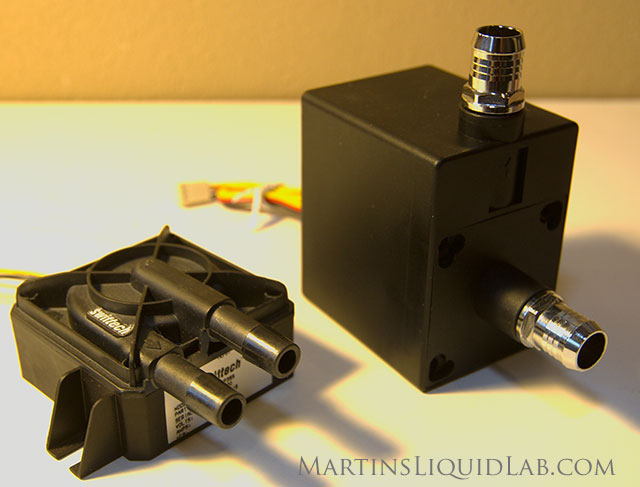
A fair amount larger than the Laing DDC 3.2 (DDC left, CPX-Pro right)

- Actual Measurements Barbs included 4.02"(103mm) length x 4.02"(103mm) height x 2.08" (54mm) width.
- Weight: 1lbs - 3.6 ounces
- G1/4 Barbs with Danger Den Fatboy HighFlow barbs, my current favorite barb!
- 3pin header with RPM monitor
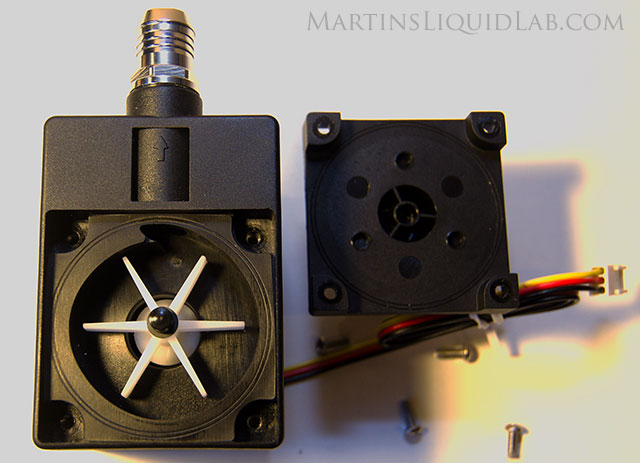
Note the spiral
shaped volute, very nice!!

Ceramic Shaft
bearing, nice!!
Hydraulics Pump Testing
The most scientific way to determine a pumps performance is to plot the entire pump pressure vs flow rate curve. This can be done by measuring pressure at the inlet and the outlet of the pump with a digital manometer and using a gate valve immediately after this pressure measurement point. This method of capturing both the inlet and outlet pressure then gives you the "Totat Dynamic Head" in pressure in (PSI) . This method is consistent with the recommendations by gouldspumps.com pump field testing technical article for field testing and I believe more accurately captures the entire power provided by a pump and will provide more accurate curves for estimating flow rates. Then utilizing this gate valve, adjusting the amount of restriction will net different flow rates and coinciding pressures the pump is producing over its curve. All of this is preferably done at a very precise 12.00V or the tested voltage as needed. While testing for pressure and flow rates, data was also collected using multi-meters to capture voltage and current in amps for power consumption data.You'll see the pressure axis is labeled as "Total Dynamic Head Pressure which is equal to the "Discharge Pressure" - "Suction Pressure". You can think of this as the reverse of pressure drop, it is "Pressure Gain" from the pump. I believe most manufacturer pump curves follow this same testing method for developing pressure. It's actually more common to refer to "Head" rather than pressure, but in water cooling we're always dealing with water, so I've had the habit of just reading in PSI and leaving it at that, so it's consistent in units with pressure drop in PSI.
Equipment:
- Dwyer Digital Manometer 477 Mark V - Accuracy .5% of Full Scale. Range 0-20.00 PSI range, Resolution .01 PSI
- King Instruments 7520 Series 0-5GPM, 250mm scale - Accuracy 2% of Full Scale. Range 0-5GPM, Resolution .1 GPM (can be interpolated to .02GPM)
- Water Source - Household water pressure - 50PSI at >5GPM - Because flow rate readings are instantaneous, household tap water and water pressure are a good and powerful source for pressure drop testing.
- Samlex PSA-305 Variable DC Power Supply - Adjusted voltage to be at 12.00V +-.03V.
- Calterm 66430 Multi-meter - Measured Voltage (DC Volts to .01V resolution)
- Cen-Tech Digital Multi-meter - Measure Current (Amps to .01 Amps Resolution)
- Mastech MS8209 Auto Ranging Multi-meter - Used for sound level decibel measurements. (.1db resolution)
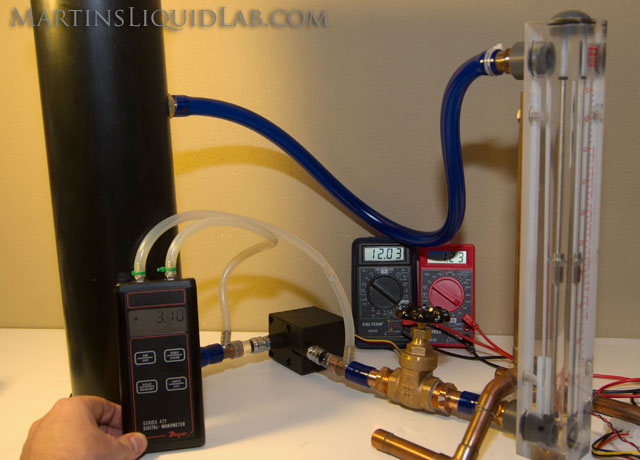

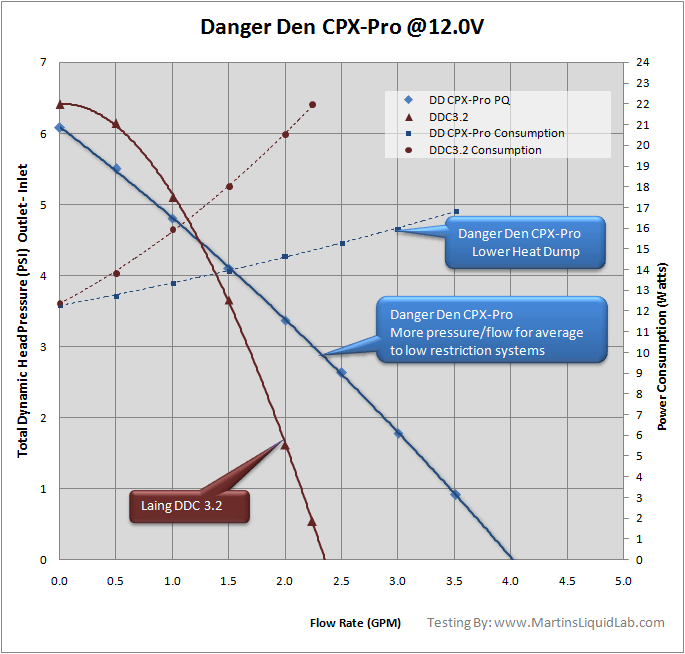
The pump performs
very well compared to the stock DDC 3.2. An average to low
restriction system would typically see higher flow rates with the
CPX-Pro, and really high restriction systems would see very slightly
more performance from the DDC. The important part that catches my attention
is the power consumption. At the 2 GPM mark, the DDC is
consuming nearly 21 watts, where then DD CPX-Pro is only consuming
about 15 watts, so the DDC at that point is consuming about 40% more
power which in the end becomes added heat to the loop.
To help put performance levels into context, I've selected a range of components for several setups. Generally anything over 1 GPM is adequate flow rate and more is better although gains are generally small past 1 GPM and even smaller past 1.5 GPM.
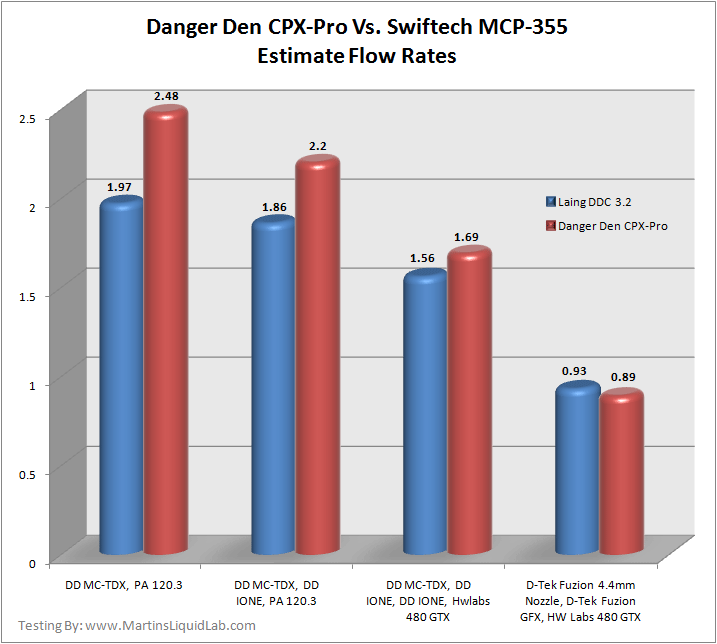
To help put performance levels into context, I've selected a range of components for several setups. Generally anything over 1 GPM is adequate flow rate and more is better although gains are generally small past 1 GPM and even smaller past 1.5 GPM.

Sound Level
Sound level is a fairly tricky thing to quantify. For one, ambient noise level affects decibel level, and second decibel level alone doesn't give you a sense of the type of sound (Some noises at the same volume are more annoying than others). I've chosen to record the sound level with my Mastech multimeter/sound level meter and record the sound using my stereo capable JVC GZ-MC500U digital video camera. This way you can get a sense of the type of sound as well as the level. I typically wait until late at night when the house is completely silent and run my sound level testing which I did in this case as well.With about a 47db ambient noise level and placing my decibel meter about 6" away, the DD CPX-Pro increased the sound level as follows:
- 12V - 51 db = 4db Gain
| Perceptions of Increases in Decibel Level | |
| Imperceptible Change | 1dB |
| Barely Perceptible Change | 3dB |
| Clearly Noticeable Change | 5dB |
| About Twice as Loud | 10dB |
| About Four Times as Loud | 20dB |
And this environment general level condition:
|
Environmental Noise |
|
| Weakest sound heard | 0dB |
| Whisper Quiet Library | 30dB |
| Normal conversation (3-5') | 60-70dB |
| Telephone dial tone | 80dB |
| City Traffic (inside car) | 85dB |
| Train whistle at 500', Truck Traffic | 90dB |
| Subway train at 200' | 95dB |
| Level at which sustained exposure may result in hearing loss | 90 - 95dB |
| Power mower at 3' | 107dB |
| Snowmobile, Motorcycle | 100dB |
| Power saw at 3' | 110dB |
| Sandblasting, Loud Rock Concert | 115dB |
So the pump added noise level fits in to the "Barely Perceptible Change" noise level, the lowest I've recorded yet, very nice!
Pros
- Excellent All Around Performance
- Spiral Shaped Volute for High Efficiency and Low Heat Dump
- 3 pin with RPM monitor (can be used to shut down computer in the event of failure)
- G 1/4 threading allows user flexibility in barb selection
- Silent, only 4db gain over ambient
- Ceramic Shaft Bearing for smooth operation and long life durability
- More compact than a Laing D5 (MPC 655)
Cons
- Larger size than the MCP 355
Bottom Line
I'm really impressed with this pump for several reasons. The smaller sibling (CPX-1) has a strong reputation for being one of the quietest pumps around, and it's nice to see this larger and more powerfull big brother pump follow suit. It's very similar in pumping power to that of the Laing DDC 3.2, but it does so with less power consumption/heat dump and it also already comes with G1/4 barbs. The DDCs and D5 are also excellent pumps, and now we have another one to choose from with similar excellent performance. This is an excellent all around pump for most water cooling systems. Danger Den tells me this pump will retail for around $54.95, so it's at an extremely competetive price point and would cost less than both the Laing D5 and the Laing DDC 3.2. Good news for us!!Where to buy
Coming soon to Danger Den
